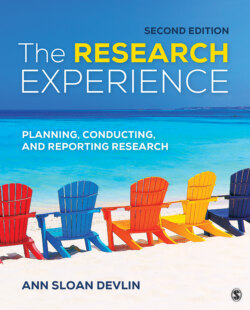Читать книгу The Research Experience - Ann Sloan Devlin - Страница 6
ОглавлениеPreface
Instructors of research methods courses face a major challenge: how to cover the necessary theoretical foundations adequately and provide enough practical help to guide students through a research project. This book is designed to accomplish both goals. The foundations of research design and methods are covered (e.g., how the nature of the research question determines the research design that is used; correlational, experimental, and qualitative designs), but there is a good deal of attention to the practical issues involved in research: finding measures, writing questionnaire items, and using online survey software such as Qualtrics®; obtaining participants and ethical review; statistical analysis; and ultimately writing a report of the research based on the format of the American Psychological Association (i.e., in APA style). Research is increasingly influenced by the availability of the Internet to conduct studies, and this book covers not only online survey software but also crowdsourcing platforms like Amazon Mechanical Turk as a source of participants. Many research methods books overlook the practical aspects of doing research. The information in this book will enable students to conduct a research methods project in a single semester.
This book can be used in a variety of social and behavioral science departments, from Psychology and Behavioral Neuroscience to Human Development, Education, and Social Work; Sociology, Criminology, and Political Science; Environmental Studies; and Communication. In addition, because research is increasingly a part of the practice of architecture, the book could be used in architecture studio courses where research is discussed. The book could be used in research methods courses taught in one or two semesters. Although statistics are covered in the book, the text is better suited for courses taught after an introductory statistics course.
The practical emphasis in the book is a major feature, and several appendices provide easily understandable summaries of fundamental issues: (a) research approaches, scale types, and associated statistical analyses; (b) a decision tree for statistical analyses (i.e., which test for which research situation); (c) commonly used “analyze” functions in IBM® SPSS® Statistics; and (d) sample informed consent and debriefing documents.
Each chapter contains several pedagogical aids to promote understanding and retention of information. For example, three kinds of questions are included in each chapter: Revisit and Respond; Try This Now; and Build Your Skills. The Revisit and Respond questions are considered review questions; the Try This Now questions push you to expand your understanding of the information just presented in the chapter or to challenge yourself to anticipate upcoming content; and the Build Your Skills questions at the end of the chapter are typically more activity-based and invite you to practice some skill introduced in the chapter (e.g., write your own survey questions). The book also contains glossary definitions in the chapter margins when a term is introduced in the text.
Updates to the New Edition
The second edition of the book preserves the qualities of the first edition but is updated in a number of significant ways. First, to recognize its importance, there is a separate chapter devoted to qualitative research. Next, recognizing that the federal policies governing research with human subjects have been significantly revised, the chapter on Ethics (Chapter 4) has been thoroughly updated to incorporate this material (i.e., the revised Common Rule went into effect in January 2019). In addition, the seventh edition of the APA Publication Manual appeared in 2020, and the text incorporates coverage of the distinctive features of that manual, including material on Bias-Free Language, as well as the new citation and reference styles (especially Chapter 13). Chapter 13 also discusses the procedure for determining authorship and ways to acknowledge specific author contributions. Further, the second edition covers the Journal Article Reporting Standards (JARS) discussed in the APA Publication Manual and how those standards change what should be reported in manuscripts submitted for publication. To provide a clearer focus, the chapter on measures has been split into two chapters; one deals with conceptual aspects of measurement and the criteria for selecting existing measures (Chapter 5); the new chapter contains the material on developing your own measures and items (Chapter 6). In the second edition, the two chapters on Experimental Research (Chapters 9 and 10) have been rewritten to emphasize both conceptual and practical considerations. Correlational and Nonexperimental Specialized Designs appear in a reorganized chapter (Chapter 7) and the experimental chapter on Within-Subjects, Mixed, and Pre–Post Designs (Chapter 10) also includes new material on ABBA and randomized block design. The second edition also includes updated information on SurveyMonkey®, Qualtrics, and a number of statistics software packages (e.g., STATA, SAS) (Chapter 6). Finally, Practice Quizzes have been added to the end of each chapter to give students more ways to test their understanding of the chapter. The answers to these quizzes appear in Appendix H.
Instructor Teaching Site
SAGE Edge for instructors supports teaching by making it easy to integrate quality content and create a rich learning environment for students.
These resources include an extensive test bank, chapter-specific PowerPoint presentations, discussion questions, SAGE journal articles with accompanying review questions, video links, and Web resources.
